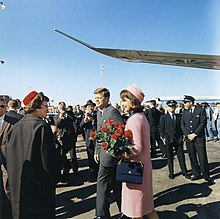Jacqueline Kennedy Onassis
- Birth Date:
- 28.07.1929
- Death date:
- 19.05.1994
- Person's maiden name:
- Jacqueline Kennedy Onassis
- Extra names:
- Žaklīna Onasis, Jacqueline Lee Bouvier Kennedy Onassis, Bouvier , Жакли́н Кеннеди Онассис, Джеклайн Ли «Джеки» Бувье Кеннеди Онассис Дже́ки Jackie, Jacqueline Bouvier Жакли́н Був
- Categories:
- First lady
- Nationality:
- american
- Cemetery:
- Arlington National Cemetery
Jacqueline Lee "Jackie" Bouvier Kennedy Onassis (pronounced pron.: /ˌˈdʒækliːn ˈliː ˈbuːvieɪ ˈkɛnɨdi oʊˈnæsɨs/;July 28, 1929 – May 19, 1994), was the wife of the 35th President of the United States, John F. Kennedy, and First Lady of the United States during his presidency from 1961 until his assassination in 1963.
Five years later she married Greek shipping magnate Aristotle Onassis; they remained married until his death in 1975. For the final two decades of her life, Jacqueline Kennedy Onassis had a career as a book editor. She is remembered for her contributions to the arts and preservation of historic architecture, her style, elegance, and grace.A fashion icon, her famous pink Chanel suit has become a symbol of her husband's assassination and one of the lasting images of the 1960s. A book containing the transcripts of interviews with Kennedy from 1964, accompanied by eight compact discs containing the audio from the interview, was released in September 2011.
Childhood
Jacqueline Lee Bouvier was born in Southampton, New York, to Wall Street stockbroker John Vernou "Black Jack" Bouvier III and Janet Norton Lee. Jackie's younger sister Lee Radziwill was born in 1933. The Bouviers divorced in 1940. Janet later married Standard Oil heir Hugh Dudley Auchincloss, Jr. in 1942 and had two more children: Janet Jennings Auchincloss and James Lee Auchincloss.
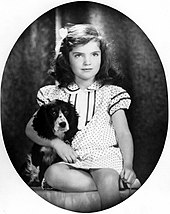

Jacqueline Bouvier in 1935
Her mother had Irish ancestry and her father's ancestry included French, Scottish, and English. Her maternal great-grandfather emigrated from Cork, Ireland, and later became the Superintendent of the New York City Public Schools. Michel Bouvier, Jacqueline's patrilineal great-great-grandfather, was born in France and was a contemporary of Joseph Bonaparte and Stephen Girard. He was a Philadelphia-based cabinetmaker, carpenter, merchant, and real estate speculator. Michel's wife, Louise Vernou, was the daughter of John Vernou, a French émigré tobacconist, and Elizabeth Clifford Lindsay, an American-born woman. Jackie's grandfather, John Vernou Bouvier Jr., fabricated a more noble ancestry for his family in his vanity family history book, Our Forebears. Recent scholarship and the research done by Jackie's cousin John H. Davis in his book, The Bouviers: Portrait of an American Family, have disproved most of these fantasy lineages.
Bouvier spent her early years in New York City and East Hampton, New York, at the Bouvier family estate, "Lasata". Following their parents' divorce, the Bouvier sisters divided their time between their mother's homes in McLean, Virginia and Newport, Rhode Island, and their father's homes in New York City at 125 East 74th Street and Long Island. Bouvier attended the Chapin School in New York City.
At a very early age, she became an enthusiastic equestrienne, and horse-riding remained a lifelong passion.
Education and young adulthood
Bouvier attended the Holton-Arms School in Bethesda, Maryland, from 1942 to 1944, and Miss Porter's School in Farmington, Connecticut, from 1944 to 1947.
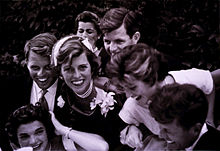

Jack and Jackie Kennedy on their wedding day, surrounded by relatives
When she made her society debut in 1947, Hearst columnist Igor Cassini dubbed her "debutante of the year."
Beginning in 1947, Bouvier spent her first two years of college at Vassar College in Poughkeepsie, New York, and then spent her junior year (1949–1950) in France – at the University of Grenoble in Grenoble, and at the Sorbonne in Paris – in a study-abroad program through Smith College in Northampton, Massachusetts. Upon returning home to the U.S., she transferred to The George Washington University in Washington, D.C.; she graduated in 1951 with a Bachelor of Arts degree in French literature. Bouvier's college graduation coincided with her sister's high school graduation, and the two spent the summer of 1951 on a trip through Europe. This trip was the subject of Jacqueline's only autobiographical book, One Special Summer, – co-authored with her sister; it is also the only one of Jacqueline's publications to feature her drawings.
Following her graduation, Bouvier was hired as "Inquiring Photographer" for The Washington Times-Herald. The position required her to pose witty questions to individuals chosen at random on the street and take their pictures to be published in the newspaper alongside selected quotations from their responses. During this time, she was engaged to a young stockbroker, John G. W. Husted, Jr., for three months. Bouvier later took continuing education classes in American History at Georgetown University in Washington, D.C.
Kennedy marriage and family


Jacqueline Kennedy at Hammersmith Farm in Newport, Rhode Island on her wedding day, September 12, 1953
Jacqueline Bouvier and then-U.S. Representative John Fitzgerald "Jack" Kennedy belonged to the same social circle and often attended the same functions. They were formally introduced by a mutual friend, journalist Charles L. Bartlett, at a dinner party in May 1952. Kennedy was then busy running for the US Senate but after his election in November, the relationship grew more serious and led to their engagement, officially announced on June 25, 1953.
They were married on September 12, 1953, at St. Mary's Church in Newport, Rhode Island, in a Mass celebrated by Boston's Archbishop Richard Cushing. The wedding was considered the social event of the season with an estimated 700 guests at the ceremony and 1,200 at the reception that followed at Hammersmith Farm.
The wedding cake was created by Plourde's Bakery in Fall River, Massachusetts. The wedding dress, now housed in the Kennedy Library in Boston, Massachusetts, and the dresses of her attendants were created by designer Ann Lowe of New York City.
The newlyweds honeymooned in Acapulco, Mexico, before settling in their new home, Hickory Hill in McLean, Virginia. Behind the glamour, however, the couple faced several personal setbacks. Jack had some serious health issues then unknown to the public: he suffered from Addison's Disease and from chronic and at times debilitating back pain due to a war injury. During the fall and winter of 1954, he underwent two delicate spinal operations which almost proved fatal. Additionally, Jackie suffered a miscarriage in 1955 and gave birth to a stillborn daughter named Arabella in 1956.
The couple ended up selling their Hickory Hill estate to Robert Kennedy, his wife Ethel Skakel, and their growing family, and bought a townhouse on N Street in Georgetown. Jacqueline subsequently gave birth to a second daughter, Caroline, in 1957, and a son, John, in 1960, both via Caesarian section. A second son, Patrick, was born prematurely in an emergency caesarean section on August 7, 1963, and died two days later.
First Lady of the United States
Campaign for Presidency
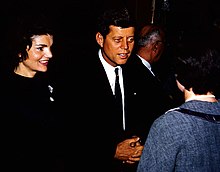

Jackie campaigning with Jack in Appleton, Wisconsin, in March 1960
On January 3, 1960, Jack announced his candidacy for the Presidency and launched his nationwide campaign. Though she had initially intended to take an active role in the campaign, Kennedy learned that she was pregnant shortly after the campaign began. Due to her previous difficult pregnancies, Kennedy's doctor instructed her to stay at home. From Georgetown, Kennedy participated in her husband's campaign by answering letters, taping television commercials, giving televised and printed interviews, and writing a weekly syndicated newspaper column, Campaign Wife. She also made rare personal appearances.
Kennedy was fluent in Spanish and French, and during her husband's presidential campaign, she spoke in Italian and Polish in public.
As First Lady
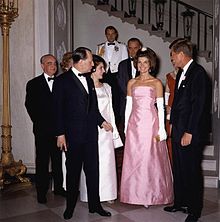

First Lady Jacqueline Bouvier Kennedy, President John F. Kennedy, André Malraux, Marie-Madeleine Lioux Malraux, Lyndon B. Johnson and Lady Bird Johnson having just descended White House Grand Staircase on their way to a dinner with the French cultural minister, April 1962. The First Lady wears a gown designed by Oleg Cassini
In the general election on November 8, 1960, John F. Kennedy narrowly beat Republican Richard Milhous Nixon in the U.S. presidential election. A little over two weeks later, Jackie gave birth to the couple's first son, John F. Kennedy, Jr. When her husband was sworn in as president on January 20, 1961, Kennedy became, at age 31, one of the youngest First Ladies in history, behind Frances Folsom Cleveland and Julia Gardiner Tyler.
Like any First Lady, Kennedy was thrust into the spotlight and while she did not mind giving interviews or being photographed, she preferred to maintain as much privacy as possible for herself and her children.
Kennedy is remembered for reorganizing entertainment for White House social events, restoring the interior of the presidential home, her taste in clothing worn during her husband's presidency, her popularity among foreign dignitaries, and leading the country in mourning after JFK's 1963 assassination.
Kennedy ranks among the most popular of First Ladies.
Social success
As First Lady, Kennedy devoted much of her time to planning social events at the White House and other state properties. She often invited artists, writers, scientists, poets, and musicians to mingle with politicians, diplomats, and statesmen. She also began to let guests at The White House drink cocktails, to give the mansion a more relaxed feeling.
Perhaps due to her skill at entertaining, Kennedy proved quite popular among international dignitaries. When Soviet Premier Nikita Khrushchev was asked to shake President Kennedy's hand for a photo, Khrushchev said, "I'd like to shake her hand first." Kennedy was well received in Paris, France, when she visited with her husband, and when she traveled with Lee to Pakistan and India in 1962.
White House restoration
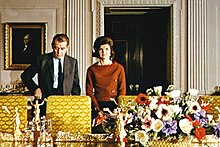

Jackie with Charles Collingwood on the broadcast tour of the restored White House (1962)


The Blue Room of the White House as redecorated by Stéphane Boudin in 1962. Boudin chose the period of the Madison administration, returning much of the original French Empire style furniture
The restoration of the White House was Kennedy's first major project as First Lady. She was dismayed during her pre-inauguration tour of the White House to find little of historic significance in the house. The rooms were furnished with undistinguished pieces that she felt lacked a sense of history. Her first efforts, begun her first day in residence (with the help of society decorator Sister Parish), were to make the family quarters attractive and suitable for family life. Among these changes was the addition of a kitchen on the family floor and rooms for her children. Upon almost immediately exhausting the funds appropriated for this effort, Kennedy established a fine arts committee to oversee and fund the restoration process and asked early American furniture expert Henry du Pont to consult.
While her initial management of the project was hardly noted at the time, later accounts have determined that she managed the conflicting agendas of Parish, du Pont, and Boudin with seamless success; she initiated publication of the first White House guidebook, whose sales further funded the restoration; she initiated a Congressional bill establishing that White House furnishings would be the property of the Smithsonian Institution, rather than available to departing ex-presidents to claim as their own; and she wrote personal requests to those who owned pieces of historical interest that might be, and later were, donated to the White House.
On February 14, 1962, Kennedy took American television viewers on a tour of the White House with Charles Collingwood of CBS News. In the tour she said, "I feel so strongly that the White House should have as fine a collection of American pictures as possible. It's so important... the setting in which the presidency is presented to the world, to foreign visitors. The American people should be proud of it. We have such a great civilization. So many foreigners don't realize it. I think this house should be the place we see them best." Working with Rachel Lambert Mellon, she oversaw redesign and replanting of the White House Rose Garden and the East Garden, which was renamed the Jacqueline Kennedy Garden after her husband's assassination. Her efforts on behalf of restoration and preservation at the White House left a lasting legacy in the form of the White House Historical Association, the Committee for the Preservation of the White House which was based upon her White House Furnishings Committee, a permanent Curator of the White House, the White House Endowment Trust, and the White House Acquisition Trust.
Broadcasting of the White House restoration greatly helped the Kennedy administration. The U.S. government sought international support during the Cold War, which it achieved by affecting public opinion. The First Lady's celebrity and high profile status made viewing the tour of the White House very desirable. The tour was filmed and distributed to 106 countries since there was a great demand to see the film. In 1962 at the 14th Annual Emmy Awards (NBC, May 22), Bob Newhart emceed from the Hollywood Palladium; Johnny Carson from the New York Astor Hotel; and NBC newsman David Brinkley hosted at the Sheraton Park Hotel in Washington D.C., and took the spotlight as a special Academy of Television Arts and Sciences Trustees Award was given to Jacqueline Kennedy for her CBS-TV tour of the White House. Lady Bird Johnson accepted for the camera-shy First Lady. The Emmy statuette is on display in the Kennedy Library located in Boston, Massachusetts. Focus and admiration for Jacqueline Kennedy took negative attention away from her husband. By attracting worldwide public attention, the First Lady gained allies for the White House and international support for the Kennedy administration and its Cold War policies.
Foreign trips
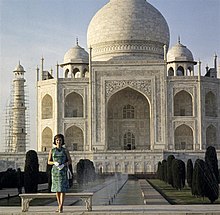

Jackie at the Taj Mahal, Agra, Uttar Pradesh, India on March 15, 1962
Before the Kennedys visited France, a television special was shot in French with the First Lady on the White House lawn. After arriving in the country, she impressed the public with her ability to speak French, as well as her extensive knowledge of French history. Kennedy had been aided in her learning of the French language by the prominent Puerto Rican educator María Teresa Babín Cortés. At the conclusion of the visit, Time magazine seemed delighted with the First Lady and noted, "There was also that fellow who came with her." Even President Kennedy joked, "I am the man who accompanied Jacqueline Kennedy to Paris — and I have enjoyed it!"

Pakistani President Ayub Khan and Jacqueline Kennedy with Sardar (1962)
At the urging of John Kenneth Galbraith, U.S. Ambassador to India, she undertook a tour of India and Pakistan, taking her sister Lee Radziwill along with her, which was amply documented in photojournalism of the time as well as in Galbraith's journals and memoirs. At the time, Ambassador Galbraith noted a considerable disjunction between Kennedy's widely-noted concern with clothes and other frivolity and, on personal acquaintance, her considerable intellect.
While in Karachi, Pakistan, she found some time to take a ride on a camel with her sister. In Lahore, Pakistan, Pakistani President Ayub Khan presented the First Lady with a much-photographed horse, Sardar (the Urdu term meaning "leader"). Subsequently this gift was widely misattributed to the king of Saudi Arabia, including in the various recollections of the Kennedy White House years by President Kennedy's friend, journalist and editor Benjamin Bradlee. While at a reception in her honor at the Shalimar Gardens, Kennedy told guests "all my life I've dreamed of coming to the Shalimar Gardens. It's even lovelier than I'd dreamed. I only wish my husband could be with me."
Death of younger son
In early 1963, Kennedy was pregnant again and curtailed her official duties. She spent most of the summer at the Kennedys' rented home on Squaw Island, near the Kennedy family's Cape Cod compound at Hyannis Port, where she went into preterm labor on August 7, 1963. She gave birth to a boy, Patrick Bouvier Kennedy, via emergency Caesarian section at Otis Air Force Base, five and a half weeks prematurely. His lungs were not fully developed, and he died at Boston Children's Hospital of hyaline membrane disease (now known as respiratory distress syndrome) on August 9, 1963.
Assassination and funeral of John F. Kennedy

Jack and Jackie at Love Field in Dallas on the day of the assassination
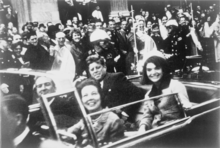

The Presidential limousine before the assassination. Jackie is in the back seat to the President's left


Jackie, still wearing the now blood stained pink suit, stands alongside as Johnson takes the oath of office.
On November 21, 1963, the First Couple left the White House for a political trip to Texas, stopping in San Antonio, Houston, and Fort Worth that day. After a breakfast on November 22, the Kennedys flew from Fort Worth's Carswell Air Force Base to Dallas' Love Field on Air Force One, accompanied by Texas Governor John Connally and his wife Nellie. The First Lady was wearing a bright pink Chanel suit. A 9.5-mile (15.3 km) motorcade was to take them to the Trade Mart, where the President was scheduled to speak at a lunch. The First Lady was seated next to her husband in the limousine, with the Governor and his wife seated in front of them. Vice President Lyndon B. Johnson and his wife followed in another car in the motorcade.
After the motorcade turned the corner onto Elm Street in Dealey Plaza, the First Lady heard what she thought to be a motorcycle backfiring and did not realize that it was a gunshot until she heard Governor Connally scream. Within 8.4 seconds, two more shots had rung out, and she leaned toward her husband. The final shot struck the President in the head. Shocked, she climbed out of the back seat and crawled over the trunk of the car. Her Secret Service agent, Clint Hill, later told the Warren Commission that he thought she had been reaching across the trunk for a piece of the President's skull that had been blown off. Hill ran to the car and leapt onto it, directing her back to her seat. The car rushed to Dallas' Parkland Hospital, and on arrival there, the president's body was rushed into a trauma room. The First Lady, for the moment, remained in a room for relatives and friends of patients just outside.
A few minutes into her husband's treatment, accompanied by the President's doctor, Dr. Malcolm Perry, she left her folding chair outside Trauma Room One and attempted to enter the operating room. Nurse Doris Nelson stopped her and attempted to bar the door to prevent her from entering. She persisted, and the President's doctor suggested she take a sedative, which she refused. "I want to be there when he dies," she told Burkley. He eventually persuaded Nelson to grant her access to Trauma Room One, saying: "It's her right, it's her prerogative."
Later, when the casket arrived, the widow removed her wedding ring and slipped it onto the President's finger. She told aide Ken O'Donnell, "Now I have nothing left."
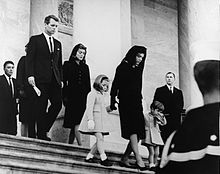

Family members depart the U.S. Capitol after a lying-in-state ceremony for the President, November 24, 1963
After the president's death, she refused to remove her blood-stained clothing and regretted having washed the blood off her face and hands. She continued to wear the blood-stained pink suit as she went on board Air Force One and stood next to Johnson when he took the oath of office as President. She told Lady Bird Johnson, "I want them to see what they have done to Jack."
Kennedy took an active role in planning the details of her husband's state funeral, which was based on Abraham Lincoln's. The funeral service was held at Cathedral of St. Matthew the Apostle, Washington D.C., and the burial at Arlington National Cemetery; the widow led the procession there on foot and lit the eternal flame at the gravesite, a flame that had been created at her request. Lady Jeanne Campbell reported back to The London Evening Standard: "Jacqueline Kennedy has given the American people... one thing they have always lacked: Majesty."
Following the assassination and the media coverage which had focused intensely on her during and after the burial, Kennedy stepped back from official public view. She did, however, make a brief appearance in Washington to honor the Secret Service agent, Clint Hill, who had climbed aboard the limousine in Dallas to try to shield her and the President.
In September 2011, audio tapes of Jackie Kennedy were released that had been recorded in 1964 after her husband's assassination. They were not supposed to be released until 50 years after her death (she died in 1994). Approximately 8.5 hours in length, the tapes contain an interview with Arthur Schlesinger Jr., in which Jackie reveals her thoughts on a wide range of topics, including the vice-president, Lyndon B. Johnson, and civil rights leader, Martin Luther King, Jr. She also discusses how she refused to leave her husband's side during the 1962 Cuban Missile Crisis when other officials had sent their wives away for their safety.
Life following the JFK assassination
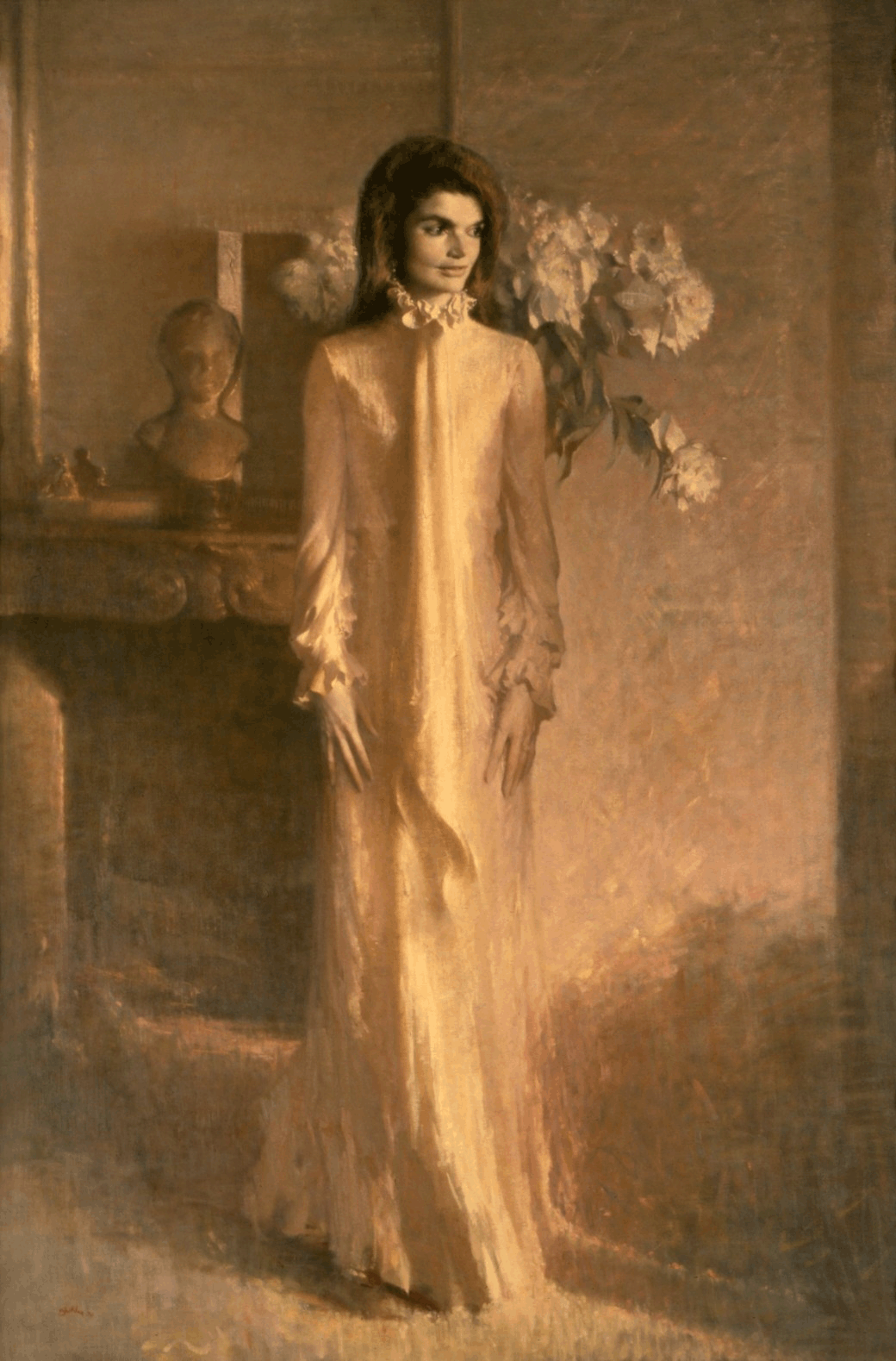

Jackie Kennedy's official White House portrait by Aaron Shikler
A week after her husband's assassination, Kennedy was interviewed in Hyannis Port, Massachusetts, on November 29 by Theodore H. White of Life magazine. In that session, she compared the Kennedy years in the White House to King Arthur's mythical Camelot, commenting that the President often played the title song of Lerner and Loewe's musical recording before retiring to bed. She also quoted Queen Guinevere from the musical, trying to express how the loss felt. Upon leaving the White House for the last time, Kennedy asked her Secret Service drivers to arrange her trips so that she would never accidentally glimpse the old mansion.
Her steadiness and courage after her husband's assassination and funeral won her admiration around the world. Following his death, Kennedy and her children remained in their quarters in the White House for two weeks, preparing to vacate. They spent the winter of 1964 in Averell Harriman's home in the Georgetown section of Washington, D.C., before purchasing their own home on the same street. Later in 1964, in the hope of having more privacy for her children, Kennedy decided to buy an apartment located at 1040 Fifth Avenue in New York City and sold her new Georgetown house and the country home in Atoka, Virginia, where she and her husband had intended to retire. She spent a year in mourning, making few public appearances; during this time, Caroline told one of her teachers that her mother cried frequently.
In 1965, Kennedy and Queen Elizabeth II dedicated Great Britain's official memorial to President Kennedy at Runnymede, England. The memorial included several acres of meadowland given in perpetuity from Britain to the U.S., near where King John had signed the Magna Carta in 1215.
Jackie perpetuated her husband's memory by attending selected, additional memorial dedications. These included the 1967 christening of the U.S. Navy aircraft carrier USS John F. Kennedy (CV-67) (decommissioned in 2007), in Newport News, Virginia, and a memorial in Hyannisport. They also included the dedication of a park near New Ross, Ireland. She also oversaw plans for the establishment of the John F. Kennedy Library, which is the repository for official papers of the Kennedy Administration. Original plans to have the library situated in Cambridge, Massachusetts, near Harvard University, proved problematic for various reasons, so it is situated in Boston. The finished library, designed by I.M. Pei, includes a museum and was dedicated in Boston in 1979 by President Jimmy Carter.
In November 1967, during the midst of the Vietnam War, Life magazine recognized Kennedy as "America's unofficial roving ambassador" during her visit to Cambodia, when she met with Chief of State Norodom Sihanouk. During the visit, Kennedy joined Sihanouk on a visit to Angkor Wat. At that point, diplomatic relations between the U.S. and Cambodia had been broken since May 1965.
Onassis marriage
In June 1968, when her brother-in-law Robert F. Kennedy was assassinated, she came to fear for her life and those of her children, saying: "If they're killing Kennedys, then my children are targets ... I want to get out of this country." On October 20, 1968, she married Aristotle Socrates Onassis, a wealthy Greek shipping magnate, who was able to provide the privacy and security she sought for herself and her children.
The wedding took place on Skorpios, Onassis's private island in the Ionian Sea, in Greece. Following her marriage, Kennedy-Onassis lost her right to Secret Service protection and her franking privilege, both of which are entitlements to a widow of a U.S. president. The marriage brought her considerable adverse publicity, and she became the target of paparazzi who followed her everywhere and nicknamed her "Jackie O".
Tragedy struck again, when Aristotle Onassis' son Alexander died in a plane crash on January 1973. Onassis' health began deteriorating rapidly and he died of respiratory failure at age 69 in Paris, on March 15, 1975. Kennedy-Onassis' financial legacy was severely limited under Greek law, which dictated how much a non-Greek surviving spouse could inherit. After two years of legal battle, she eventually accepted from Christina Onassis, Onassis' daughter and sole heir, a settlement of $26 million, waiving all other claims to the Onassis estate.
During their marriage the couple inhabited five different residences: her 15-room Fifth Ave. apartment in New York City, her horse farm in New Jersey, his Avenue Foch apartment in Paris, his private island in Greece named Skorpios, and his 325 ft (99 m) yacht The Christina.
Later years
Onassis' death in 1975 made Kennedy-Onassis a widow for the second time. Now that her children were older, she decided to find work that would be fulfilling to her. Since she had always enjoyed writing and literature, in 1975 she accepted a job offer as an editor at Viking Press. But, in 1978, the President of Viking Press, Thomas H. Guinzburg, authorized the purchase of the Jeffrey Archer novel Shall We Tell the President?, which was set in a fictional future presidency of Ted Kennedy and described an assassination plot against him. Although Guinzburg cleared the book purchase and publication with Onassis, upon the publication of a negative New York Times review which asserted that Onassis held some responsibility for its publication, she abruptly resigned from Viking Press the next day. She then moved to Doubleday as an associate editor under an old friend, John Sargent, and lived in New York City, Martha's Vineyard, and the Kennedy Compound in Hyannis, Massachusetts. From the mid-1970s until her death, her companion was Maurice Tempelsman, a Belgian-born industrialist and diamond merchant who was long separated from his wife.
She remained the subject of considerable press attention, most notoriously involving the photographer Ron Galella. He followed her around and photographed her as she went about her day-to-day activities, obtaining candid photos of her. She ultimately obtained a restraining order against him, and the situation brought attention to paparazzi-style photography. In 1995, John F. Kennedy, Jr. allowed Galella to photograph him at public events.


Jackie in 1985 with the President and First Lady, Ronald and Nancy Reagan
Among the many books Kennedy-Onassis edited was Larry Gonick's The Cartoon History of the Universe. He expressed his gratitude in the acknowledgments in Volume 2.
Kennedy-Onassis also appreciated the contributions of African-American writers to the American literary canon. She encouraged Dorothy West, her neighbor on Martha's Vineyard and the last surviving member of the Harlem Renaissance, to complete the novel The Wedding (1995), a multi-generational story about race, class, wealth, and power in the U.S.; West acknowledged Onassis' encouragement in the foreword. The novel, which received literary acclaim when it was published by Doubleday, was later adapted into a television miniseries of the same name (1998) starring Halle Berry.
Kennedy-Onassis also worked to preserve and protect America's cultural heritage. The notable results of her hard work include Lafayette Square in Washington, D.C. and Grand Central Terminal, New York City's historic railroad station. While First Lady, she helped to stop the destruction of historic homes in Lafayette Square, because she felt these buildings were an important part of the nation's capital and played an essential role in its history. Later, in New York City, she led an historic preservation campaign to save from demolition and renovate Grand Central Terminal. A plaque inside the terminal acknowledges her prominent role in its preservation. In the 1980s, she was a major figure in protests against a planned skyscraper at Columbus Circle which would have cast large shadows on Central Park; the project was cancelled, but a large twin-towered skyscraper would later fill in that spot in 2003, the Time Warner Center.
From her apartment windows in New York City she had a splendid view of a glass-enclosed wing of the Metropolitan Museum of Art, which displays the Temple of Dendur. This was a gift from Egypt to the U.S. in gratitude for the generosity of the Kennedy administration, which had been instrumental in saving several temples and objects of Egyptian antiquity that would otherwise have been flooded after the construction of the Aswan Dam.
Death and funeral


Grave of Jacqueline Bouvier Kennedy Onassis at Arlington National Cemetery (2006)
In January 1994, Onassis was diagnosed with non-Hodgkin's lymphoma, a form of cancer. Her diagnosis was announced to the public the following month. The family and doctors were initially optimistic, and she stopped smoking at the insistence of her daughter, having previously been a three-pack-a-day smoker. She continued her work with Doubleday, but curtailed her schedule. The cancer proved to be aggressive, and by April had spread. She made her last trip home from New York Hospital-Cornell Medical Center on Wednesday, May 18, 1994. A large crowd of well-wishers and reporters gathered on the street outside her apartment. The following night at 10:15 p.m. Onassis died in her sleep. It was Thursday, May 19, 1994, two and a half months before her 65th birthday. Her son, John F. Kennedy, Jr., announced her death with the following: "My mother died surrounded by her friends and her family and her books, and the people and the things that she loved. She did it in her own way, and on her own terms, and we all feel lucky for that."
Kennedy-Onassis' funeral was held on May 23, 1994 at Saint Ignatius Loyola Church in Manhattan — the church where she was baptized in 1929 and confirmed as a teenager. At her funeral, her son John described three of her attributes as the love of words, the bonds of home and family, and the spirit of adventure. She was buried alongside President Kennedy, their son Patrick, and their stillborn daughter Arabella at Arlington National Cemetery in Arlington, Virginia.
In her will, Kennedy-Onassis left her children Caroline and John an estate valued at $43.7 million by its executors.
Fashion icon


Jack and Jackie watching America's Cup race on board the USS Joseph P. Kennedy Jr., September 1962
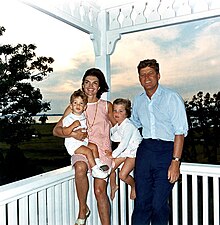

John-John, Jackie, Caroline, and Jack in 1962
During her husband's presidency, Jacqueline Kennedy became a symbol of fashion for women worldwide. She retained French-born American fashion designer and Kennedy family friend Oleg Cassini in the fall of 1960 to create an original wardrobe for her as First Lady. From 1961 to late 1963, Cassini dressed her in many of her most iconic ensembles, including her Inauguration Day fawn coat and Inaugural gala gown, as well as many outfits for her visits to Europe, India, and Pakistan. In her first year in the White House, Kennedy spent $45,446 more on fashion than the $100,000 annual salary her husband earned as president (He donated the annual salary to charity). Her clean suits with a skirt hem down to middle of the knee, three-quarter sleeves on notch-collar jackets, sleeveless A-line dresses, above-the-elbow gloves, low-heel pumps, and famous pillbox hats were overnight successes around the world and quickly became known as the "Jackie" look. Although Cassini was her primary designer, she also wore ensembles by French fashion legends such as Chanel, Givenchy, and Dior. More than any other First Lady her style was copied by commercial manufacturers and a large segment of young women. Her influential bouffant hairstyle, described as a "grown-up exaggeration of little girls' hair", was created by Kenneth, whom she had been seeing since 1954, and who continued to style her hair until 1986.
In the years after the White House, her style changed dramatically. Gone were the modest "campaign wife" clothes. Wide-leg pantsuits, large lapel jackets, gypsy skirts, silk Hermès head scarves, and large, round, dark sunglasses became her new look. She often chose to wear brighter colors and patterns and even began wearing jeans in public. Beltless, white jeans with a black turtleneck, never tucked in, but pulled down over the hips, was another fashion trend that she set.
Throughout her lifetime, Kennedy acquired a large collection of exquisite and priceless jewelry. Her triple-strand pearl necklace designed by American jeweler Kenneth Jay Lane became her signature piece of jewelry during her time as First Lady in the White House. Often referred to as the "berry brooch", the two-fruit cluster brooch of strawberries made of rubies with stems and leaves of diamonds, designed by French jeweler Jean Schlumberger for Tiffany & Co., was personally selected and given to her by her husband several days prior to his inauguration in January 1961. Kennedy wore Schlumberger's gold and enamel bracelets so frequently in the early and mid-1960s that the press called them "Jackie bracelets"; she also favored his white enamel and gold "banana" earrings. Kennedy wore jewelry designed by Van Cleef & Arpels throughout the 1950s, 1960s and 1970s; her sentimental favorite was the Van Cleef & Arpels wedding ring given to her by President Kennedy.
She was named to the International Best Dressed List Hall of Fame in 1965.
Honors and memorials
- A high school named Jacqueline Kennedy Onassis High School for International Careers, was dedicated by New York City in 1995, the first high school named in her honor. It is located at 120 West 46th Street between Sixth and Seventh Avenues, and was formerly the High School for the Performing Arts.
- In December 1999, Onassis was among 18 included in Gallup's List of Widely Admired People of the 20th Century, from a poll conducted of the American people.
- The main reservoir in Central Park, located in New York City, New York, was renamed in her honor as the Jacqueline Kennedy Onassis Reservoir.
- The Municipal Art Society of New York presents the Jacqueline Kennedy Onassis Medal to an individual whose work and deeds have made an outstanding contribution to the city of New York. The medal was named in honor of the former MAS board member in 1994, for her tireless efforts to preserve and protect New York City's great architecture.
- At George Washington University, a residence hall located on the southeast corner of I and 23rd streets NW in Washington, D.C., was renamed Jacqueline Bouvier Kennedy Onassis Hall in honor of the alumna.
- The White House's East Garden was renamed the Jacqueline Kennedy Garden in her honor.
- In 2007, her name and her first husband's were included on the list of people aboard the Japanese Kaguya mission to the moon launched on September 14, as part of The Planetary Society's "Wish Upon The Moon" campaign. In addition, they are included on the list aboard NASA's Lunar Reconnaissance Orbiter mission.
- A school and an award at the American Ballet Theatre have been named after her in honor of her childhood study of ballet.
- The companion book for a series of interviews between mythologist Joseph Campbell and Bill Moyers, The Power of Myth, was created under the direction of Onassis, prior to her death. The book's editor, Betty Sue Flowers, writes in the Editor's Note to The Power of Myth: "I am grateful... to Jacqueline Lee Bouvier Kennedy Onassis, the Doubleday editor, whose interest in the books of Joseph Campbell was the prime mover in the publication of this book." A year after her death in 1994, Moyers dedicated the companion book for his PBS series, The Language of Life to Onassis. The dedication read: "To Jacqueline Kennedy Onassis. As you sail on to Ithaka." Ithaka was a reference to the C.P. Cavafy poem that Maurice Tempelsman read at her funeral.
- A white gazebo is dedicated to Jacqueline Kennedy Onassis on North Madison Street in Middleburg, Virginia. Jacqueline and President Kennedy frequented the small town of Middleburg and intended to retire in the nearby town of Atoka. She also hunted with the Middleburg Hunt numerous times.
Source: wikipedia.org
| Title | From | To | Images | Languages | |
|---|---|---|---|---|---|
 | Nightclub Studio 54 | de, ee, en, fr, lt, lv, pl, ru |







